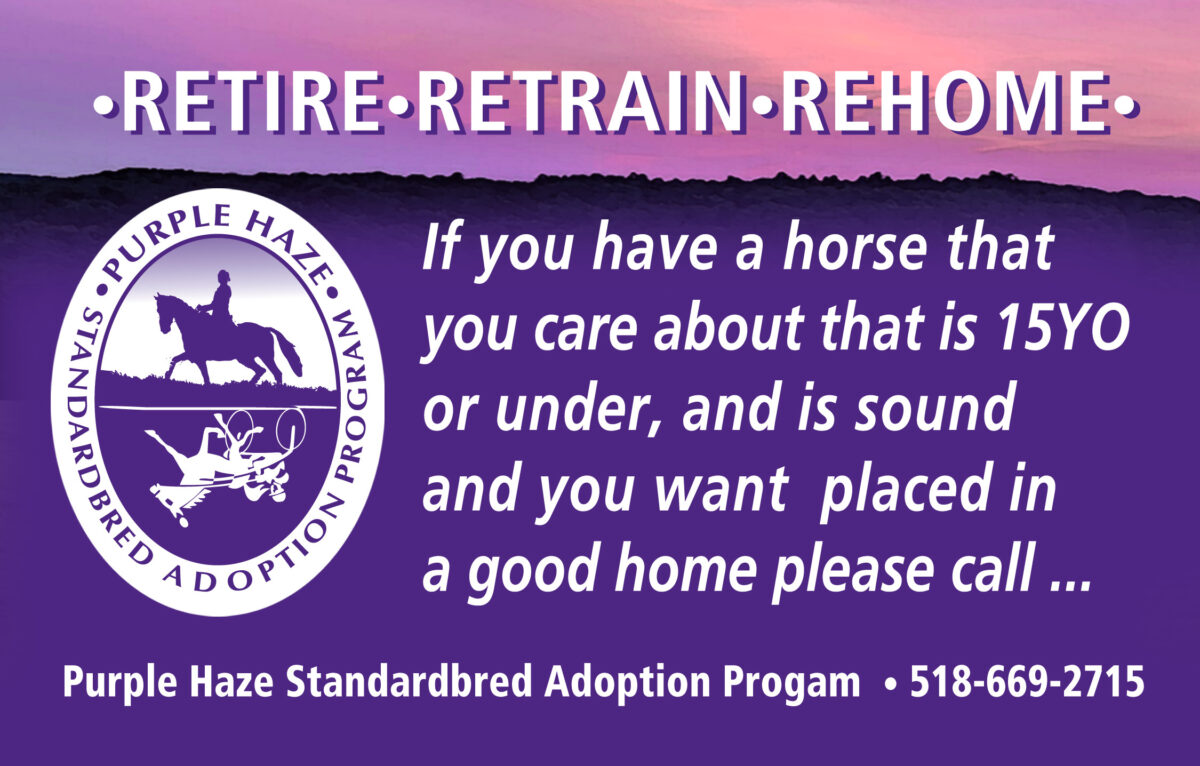Making the grade
Graded stakes committee chair Mark Loewe details how the group came up with harness racing’s first list and why some races made the cut and others did not.
by Dave Briggs
Mark Loewe said he expected harness racing’s inaugural graded stakes list would spark some controversy. After all, many people in the sport long ago made their own determinations about which stakes races mattered most. Naturally, the official graded stakes list, which was 18 months in the making, wasn’t going to line up with everyone’s belief system.
“We realize there’s a lot of conversation that can be had over this,” said Loewe, the chair of the graded stakes committee. “We could talk about it for 10 hours.”
Though the list was only released publicly on Jan. 7, Loewe said he’s been surprised about the lack of feedback, so far. That will likely change as people fully process which stakes were assigned a grade of 1, 2 or 3. Loewe said the sport is better for having the debate.
“[It is] controversial, maybe, and creates dialogue, but that’s a good thing,” Loewe said. “We don’t have enough dialogue.
“I’ve had some good feedback, but I wouldn’t say I’ve been overwhelmed one way or the other. I think as the year goes on, and if people are willing to and want to promote it properly, I think it can be beneficial. It will not be on program race lines just yet… It will be in sales catalogs, but you can easily have a racetrack publicize your race and put it in your header as ‘the Grade 1 Hambletonian’ or ‘the Grade 1 North America Cup.’ It’s entirely up to the racetracks, but it’s just another tool to market a race for them.”
As for which stakes made the cut as Grade 1s and which did not, the good news is the list is fluid and there will be a yearly review of the grade for all stakes.
“Races can go up, races can go down and we’ve got guidance to help us make those decisions,” Loewe said. “We expect committee members to use their expertise and knowledge. It doesn’t have to be 100 per cent based on what we see if the committee feels strongly enough that a race justifies being moved up or down.
“We really put a lot of time and effort into this to do what we thought was right. I actually went to the race secretary meetings twice to discuss it, and there were virtually no questions asked. An individual last year said, ‘Why would we want to do anything that the thoroughbreds are doing? Their business sucks and look at this…’ This year, that individual found a reason to leave the room when I discussed it again.”
PURSES KEY TO GRADING
Loewe said the committee – himself, David Reid, Mike Klau, Mark McKelvie, Steve Jones, Rich Mattei, Seth Rosenfeld, Steve Stewart, Chris Antonacci, Darryl Kaplan, and Pete Szymanski – essentially started with “a blank palette” and decided the logical place to start was with purses, followed by the field quality of those races in last four or five years.
“We bandied about what is the proper purse to be a Grade 1, Grade 2 or Grade 3,” Loewe said. “That took two-to-three months of zoom calls to discuss.”
In the end, the committee decided the purse thresholds would be as follows:
Male
Grade 1 – $350,000 and up
Grade 2 – $175,000 – $349,999
Grade 3 – $75,000 – $174,499
Female
Grade 1 – $250,000 and up
Grade 2 – $125,000 – $249,999
Grade 3 – $75,000 – $124,999
“At one point, we had a higher threshold for Grade 1 than what we ended up doing and we talked about potentially a lower threshold for a Grade 3 and we came to a medium,” Loewe said. “At one point it was $100,000 for Grade 3, then we talked about how there were a number of historical races that unfortunately have lost a lot of cred and do we get to the point where we drop it to $50,000? Well, then you’ve got this one at $48,500… so there was a lot of dialogue just to figure out what’s an appropriate threshold for 1s, 2s and 3s.
“Once we got that, then it was a matter of doing some data mining, basically, with the help of the USTA. I got charts from 2021 or 2020 through 2024 of every race that met the purse criteria. Then, we went through all of these races and started [assigning] a point value to each race based on the quality of the field.”
Loewe said the purse used was that of the race’s host nation. That means the purse of Canadian stakes races were considered on par with U.S. ones.
“A lot of people say, ‘Yeah, but [in Canada you are] only racing for 65 or 70 cents [in U.S. money],’” Loewe said. “But, in three years, it could be the other way.”
In fact, between 2011 and 2012 the Canadian dollar was worth more than the U.S. one.
Only open stakes were graded with a G. The committee also rated the sires stakes finals in each jurisdiction with an R1, R2 or R3. But, let’s save that discussion for another day.
STAKES WITH DIVISIONS CANNOT BE GRADE 1
It’s important to note the committee decided that any stake that can be split into divisions cannot be classified as a Grade 1.
InFriday’s HRU, Brett Sturman criticized the William Haughton being listed as a Grade 2 stakes race.
“Unquestionably, and even more-so when compared to where other stakes in the division have been designated, the Haughton is a signature race for open pacers and should have G1 status,” Sturman wrote. “The list of winners in the stake is a who’s-who of the very best open pacers over the last 30 years and was further highlighted when it was the race of the year in 2022 when Bulldog Hanover broke the 1:46 time barrier.”
Loewe said the committee, “spoke for four months about the Haughton, but we also had to come to a basic understanding that there has to be guidelines and there has to be rules that we follow. One of the biggest things that we had to discuss – and this was discussed for years – is that a race that splits into divisions, or that the conditions say it can be spilt into divisions, cannot be a Grade 1.
“The Haughton is written where it can go to divisions and, in 2021, it did race in divisions. So, that was the primary struggle. It’s the Haughton, yes, but if we’re going to say divisions then it’s divisions for all races across the board. We can’t say that Bluegrass divisions matter, but not the Haughton divisions.”
As for races like the Little Brown Jug and Jugette that are contested in heats, the committee considered those heats eliminations, not divisions.
Meanwhile, the Matron Stakes are a good example of field quality being part of the grading system.
The Matrons for 2- and 3-old filly pacers and 2- and 3-year-old filly trotters are Grade 2 events.
The Matrons for 2- and 3-year-old open pacers and 3-year-old open trotters are Grade 3 events.
The 2-year-old open trot Matron did not earn a grade.
“There was some banter on Facebook that they didn’t even grade the Matron Stake for 2-year-old trotting colts,” Loewe said. “There’s a pretty simple explanation. In 2023, it did not fill. In 2024, it did not fill. Yes, we graded it in 2021 and 2022 and now it falls off the map when it goes two years without being run.”
Sturman also criticized the Six Pack being listed as a Grade 3. Loewe said, “The Six Pack was a six-horse field, six-horse field and five-horse field the last three years,” which impacted its ranking.
As for three Triple Crown races having a G2 standing — the Messenger, Cane and Yonkers Trot — Loewe said there was a lot of discussion about that on the committee.
“In 1955 they decided the Triple Crown,” Loewe said. “Does that mean in 2025 that we can’t say there’s a North American trifecta of races that most people today think are the Triple Crown?
“In the end, we felt that we had guidance and rules and we had to follow them regardless of whether the race was a ‘Triple Crown’ race or not and where we landed on that is that they don’t fit the criteria, they don’t fit the guidance, the quality of the fields aren’t there… We could get into discussions ad nauseum about whether we should give a bias because it’s a half-mile track or this or that.”
There was also some chatter online about some of the Sun Stakes races being a Grade 1 – the Delmonica Hanover and the Lynch – while the Max Hempt and Beal are Grade 2s.
“A lot of that was predicated on purse level,” Loewe said. “The open paces and open trots go for $300,000 and the threshold that we had decided was $350,000 for Grade 1. Again, because we felt that the mares never had the opportunity to race for that kind of money and we did set it at $250,000 threshold for the mares, that’s why Delmonica Hanover is a Grade 1 and the Beal is a Grade 2.
“Now, I did tell [Pennsylvanian Harness Horse Association president] Sam Beegle, ‘You can easily fix this.’ If you put in a Beal 1 consolation and a Beal 2 consolation. Maybe if the Beal 1 consolation went for $175,000 and the Beal 2 consolation went for $75,000 and you took that extra $25,000 from each of those races and put it into the open Beal, then it would probably make it a lot easier for the committee to call it a Grade 1.
“[Racetracks] can make [purse] adjustments if it is important enough to them.”
REASONS FOR GRADED STAKES
Loewe said graded stakes, “is important for breeders, for horsemen, for racetracks, for sales companies… They can point specifically to very important races that have a huge impact on the industry and that they are proud to sell horses that have won those races, stallions that have won major races, mares that have won major races. I think it’s important for everyone in the industry to be able to specifically point to something and say, ‘Look, we have 14 Grade 1s here.’”
He said there are at least five good reasons for adopting Graded Stakes:
• It elevates the importance of certain stakes races to those that are not immersed in the industry. “There are obviously people in the industry who know every race backwards and forwards and have in their mind what’s a 1, 2 and 3, but a lot of people in the industry aren’t as savvy,” Loewe said. “Also, there are a lot of people outside the industry, that if you start attaching a Grade 1 to the race, then they get it. That’s been thrown at them on the thoroughbred side forever.”
• It helps breeders promote stallions, mares and yearlings and make breeding decisions. “If I’m standing a stallion I can say, ‘Winner of four Grade 1 stakes,’” Loewe said.
• It will help tracks drive handle for big events. “[Thoroughbred tracks] tell me that the handle is up when they are showing graded stakes and they promote graded stakes,” Loewe said. “It can be a marketing tool to promote pari-mutuel wagering.”
• It could help determine awards and honors. “If we have a list of 20-something horses – all of them top quality horses, but this one had seven Grade 1 wins and this one made a lot of money, but only had two Grade 1 stakes, that may impact how the committee votes on who should be in the Living Hall of Fame,” Loewe said.
• Europe is already grading North American races. “Sweden will grade our races to determine whether the horse can stand as a stallion in that country,” Loewe said. “Why should a foreign country be grading our races if we’re not doing it ourselves?”
To learn more, including other criteria for grading as well as statistics considered and the point system utilized by the committee, clickhere.
For the complete list of Grade 1, 2 and 3 Stakes, click here.
The complete schedule of both graded and restricted graded stakes will be announced at a later date.


















